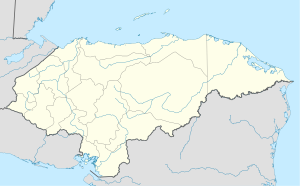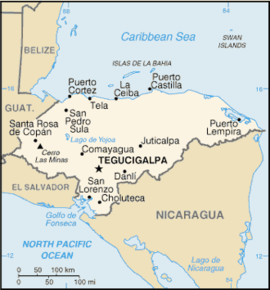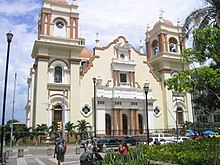San Pedro Sula
| San Pedro Sula | ||
|---|---|---|
|
Coordinates: 15 ° 30 ′ N , 88 ° 1 ′ W San Pedro Sula on the map of Honduras
|
||
|
Location of San Pedro Sula in Honduras
|
||
| Basic data | ||
| Country | Honduras | |
| Department | Cortés | |
| City foundation | June 27, 1536 | |
| Residents | 598,519 (2013 census) | |
| - in the metropolitan area | 710,000 | |
| City insignia | ||
| Detailed data | ||
| surface | 136 km 2 | |
| Population density | 3,698 inhabitants / km 2 | |
| prefix | (+504) 50 | |
| Time zone | UTC −6 | |
| City Presidency | Armando Calidonio | |
| Railway station in San Pedro Sula | ||
San Pedro Sula is the second largest city in Honduras after Tegucigalpa with about one million inhabitants (with agglomeration). While Tegucigalpa is the country's administrative center, San Pedro Sula is the commercial one. This economic importance is due, among other things, to the proximity to Honduras 'only major seaport in Puerto Cortés , which is only 45 minutes' drive from the city center of San Pedro Sula. In addition, the main connection road to the north and west runs through San Pedro Sula. Despite this commercial importance, San Pedro Sula is considered an extremely dangerous city, mainly due to the local drug crime. For several years in a row, it was the city with the highest number of homicides per 100,000 people in the world.
The city was founded in 1536. Don Pedro de Alvarado as Villa de San Pedro de Puerto Caballos is considered the city's founding father. San Pedro Sula is the industrial center of Honduras with light industry and the commercial production of coffee, bananas, beef, cane sugar, tobacco and wood; San Pedro Sula is also an important traffic junction. The city is located in the northwest of the country, about 40 km from the Caribbean coast at an altitude of about 70 m. San Pedro Sula extends in the wide valley of Valle de Sula and is the capital of the department of Cortés.
history
San Pedro Sula was founded on June 27, 1536 by Pedro de Alvarado with the name Villa de San Pedro de Puerto Caballos near the town of Choloma . At that time there were already around 18 towns in the valley that were inhabited by locals. The early description of the landscape suggests abundant marshland and dense rainforest, with small fields suitable for agriculture and cattle breeding. After several name changes, the city has been called San Pedro Sula since the 18th century. The "Sula" comes from the Minas de Sula, gold mines, which are located west of the village of Naco .
For the first five years of its history, San Pedro Sula served as a colonial mint as gold was found near the villages of Naco, Sula, and in the Quimistan Valleys. The gold had to be brought in and melted. A fifth of the gold had to be given to the Spanish colonial rulers. The gold was moved on to Gracias a Dios in the 1550s and eventually to Comayagua .
French, English and Dutch pirates raided and pillaged the city, after which the Spanish moved the city to its current location on the Chamelecon River . As a result, San Pedro became a small town with only a few Spanish settlers. New settlers preferred to move to higher and drier inland valleys with more farmland and gold mines. The city grew very slowly from around 800 inhabitants in 1590 to just under 10,000 in 1890. The greatest population growth took place in the 19th century. In the mid-1920s, the city's population rose from 10,000 to 100,000 due to the flourishing economy in the region's banana plantations. Today the metropolitan region has around 1 million inhabitants and the trend is rising. The construction of a train connection between San Pedro Sula and the seaports of Tela and Puerto Cortés connects the banana plantations with the sea. This also promoted the development of San Pedro Sula as an industrial city.
Population development
The following overview shows the population by area since the 1988 census.
| year | population |
|---|---|
| 1988 (census) | 298,385 |
| 2001 (census) | 483.384 |
| 2013 (census) | 598,519 |
City subdivision
San Pedro Sula, like most cities under Spanish colonial rule, is divided into squares. So-called "Avenidas" run through the city from north to south, and so-called "calles" (streets) run through the city in an east-west direction. The first street and the first avenue mark the center of the city and divide the city into four main squares NW, NE, SW and SE. The actual center is located in the central park on the first street and third avenue. As in many other Latin American cities, the cathedral and town hall are located in front of the central park.
Tourism and Places of Interest
San Pedro Sula can serve as a starting point for many different tourist destinations. A goal that is often targeted are e.g. B. the Mayan Copán ruins, which are about three hours from San Pedro Sula.
Other tourist destinations include Lake Yojoa (the largest natural lake in Honduras) and Pulhapanzak Falls, the Cusuco Cloud cloud forest (where birds, orchids , bromeliads, and sometimes tapirs and armadillos can be seen), and Tela. Also in a short distance are the towns of Puerto Cortés and Omoa with their long beaches.
Attractions
Museums
- Museo de Antropología e Historia
- Museo de la Naturaleza
- Planetario Infantil
The Museo de Antropología e Historia is licensed by the Honduran Institute for Anthropology and History and houses archaeological and historical collections which by law belong to the Honduran people. The ground floor of the museum is dedicated to the history of Honduras and in particular San Pedro Sula. The upper floor has an exhibition about the early history of the valley in which the city of San Pedro Sula is located today. The museum has a library on Honduran history. Teresa de Pastor is currently the director of the museum.
The second museum deals with the flora and fauna in the area of San Pedro Sula. It shows different species of insects, as well as books on nature and animals found in the Meredon Mountains . The director of the museum is Gladys Fasquelle de Pastor.
The planetarium shows the night sky as it can be seen in San Pedro Sula. The visitor is given information about the solar system and the constellations. There is also a small exhibition area.
Shopping centers
- City Mall Circunvalación
- Multiplaza
- Megaplaza
- Metroplaza
- Galerias del Valle
Central Park
In the city center there is a small pavilion that marks the place where San Pedro Sula was founded.
Zona de Armenta
The Zona de Armenta is a river that carries cold water. This water comes from the Meredon Mountains. There is also a park here, which is located in the northeast. Many residents go to this park to relax from everyday stress. There are several opportunities for swimming in the river itself. There are also opportunities to buy something to eat there.
Mercado Guamilito
Vendors sell handicrafts, pottery, souvenirs, flowers and local Honduran food.
theatre
- Francisco Saybe Theater
- Centro Cultural Sampedrano
- Torre Universitaria
- Jorge Emilio Jaar
- USPS campus
Water parks
- Wonderland
- Zizima Eco water park
- Armenta
Avenida Circunvalacion
The Avenida Circunvalacion is the most popular nightlife area. There are restaurants, pubs and many events such as the Feria Juniana, which takes place in June and therefore bears this name.
traffic
Air traffic
With the Ramón Villeda Morales International Airport , also known as La Mesa International Airport , the city has an international airport. It is located approx. 12 km southeast of the city center. Flights are offered by both domestic and international airlines such as E.g .: United , American , Delta , COPA , Spirit Airlines , Aeroméxico , Maya Island Air and TACA , which cover the city with San Salvador , Mexico City , Panama City , Guatemala City , San José , Belize City , Cancún , Managua , Atlanta , Fort Lauderdale , Houston , Newark , New Orleans , Miami and New York connects.
Ramón Villeda Morales Airport is the main and busiest airport in Honduras, handling approximately 600,000 passengers in 2007. From November 2015 to October 2016 there were 748,244 passengers, of whom 685,424 made domestic and 62,820 international departures. The number of passengers departing from Ramón Villeda Morales Airport was 41.3% of all departures from the four airports in Honduras. When leaving the country, travelers have to pay a departure fee of around US $ 39 (as of 2013), which is intended to serve the airport expansion.
Public transportation
San Pedro Sula has a central bus station, the Gran Central Metropolitana de Autobuses, which is used by the main bus companies. It is located a few kilometers from the city center and offers visitors the opportunity to go to almost all domestic and international destinations. Not only is it the largest bus terminal in Central America, it also has a shopping mall, food court, and many other things.
San Pedro Sula has city buses that run fixed routes through the city. Seven bus routes run from almost the entire city area, but you can't expect any regular departure times or timetables. From the outside it is seldom to be seen which route the respective buses are taking. Minibuses, called "Rapiditos", are minivans that can move faster in city traffic. There are also numerous taxis. All taxis in San Pedro Suls are white and have a clearly visible registration number on the car. Another means of transport are the "colectivos" (shared taxis).
safety
San Pedro Sula is indisputably one of the most dangerous cities in the world. In 2014, 1,317 homicides were registered in the city. In a global comparison of cities (more than 300,000 inhabitants), San Pedro Sula was in first place for the fourth time in a row this year with 171.2 homicides / 100,000 inhabitants. In New York there are an average of 6.2 homicides per 100,000 population and in London 1.2. In addition, part of the city's police force is considered corrupt ; According to the international news agency Associated Press , the Honduras prosecutor's office received around 50 official complaints within three years in the early 2010s, in which the police are also accused of homicides.
According to individual studies, the high level of crime is a result of the weak state authority and, at the same time, the economic importance of San Pedro Sula. Since 2005 numerous textile companies have settled in the tax-exempt zone between the city and the port of Puerto Cortés. This industry arose because in this special economic zone they are allowed to import tax-free fabrics and yarns from other countries and to produce textiles for export on behalf of companies such as Gap , Nike and Adidas . This has resulted in this area becoming the most economically valuable in Honduras. Much of the violence in the city can be traced back to clashes between different criminal groups, each trying to control parts of this area for the purpose of extortion. Something similar is repeated in other urban centers such as the central bus station, the markets and the small shops that line the roads leading into the city. In addition, San Pedro Sula plays an important role in the international drug trade. San Pedro Sula is an essential hub for cocaine , which arrives here from South and Central America and the Caribbean by land, air and sea. The drug trade is dominated by Mexican groups such as the Sinaloa cartel and Los Zetas , which in turn use Honduran gangs to transport the drugs. The Sinaloa cartel appears to dominate overland drug traffic to Guatemala and Mexico. By contrast, drug trafficking by sea seems to be largely under the control of Los Zeros. This development reached a high point in 2004/2005, when the fight against drug trafficking in Colombia and the Caribbean showed initial successes and ultimately led to international drug cartels increasingly conducting their trade via other channels and, within this framework, the special situation in Honduras discovered for their purposes. The cartels used existing structures of criminal Honduran gangs and resorted to them for operational activities in the country. Most of the Honduran gangs are paid with cocaine, which led to an offer for domestic drug use in Honduras. Part of the violence in the city can therefore also be traced back to the fight by Honduran gangs for shares in this domestic drug market. At the same time, drug cartels are using the weakened state authority in Honduras to launder money here and redirect it to legitimate channels.
The potential for violence in San Pedro Sula is also increased by the deportation policy of the United States . In 2012 alone, the United States deported more than 32,000 Honduran citizens, nearly half of whom were serious criminals and many of whom belong to criminal gangs such as the Mara Salvatrucha or the 18th Street Gang .
Individual incidents show the brutality of the gangs prevailing in San Pedro Sula. In June 2009, 18 imprisoned members of the Mara Salvatrucha broke out of prison in San Pedro Sula. The criminals, some of whom were convicted of murder, dug a 15-meter-long tunnel into a neighboring house, which was brought under their control by a dozen other Mara 18 members. They managed to escape with the vehicles provided. Two of the fugitives were involved in the kidnapping and murder of 14-year-old Edwin Palacios. The brother of the England football player Wilson Palacios was kidnapped in Honduras in 2008 . The kidnappers demanded a ransom from the Honduran international. Finally, Edwin Palacios was found dead in a village in May 2009.
Climate table
| San Pedro Sula | ||||||||||||||||||||||||||||||||||||||||||||||||
|---|---|---|---|---|---|---|---|---|---|---|---|---|---|---|---|---|---|---|---|---|---|---|---|---|---|---|---|---|---|---|---|---|---|---|---|---|---|---|---|---|---|---|---|---|---|---|---|---|
| Climate diagram | ||||||||||||||||||||||||||||||||||||||||||||||||
| ||||||||||||||||||||||||||||||||||||||||||||||||
|
Average monthly temperatures and rainfall for San Pedro Sula
Source: wetterkontor.de
|
|||||||||||||||||||||||||||||||||||||||||||||||||||||||||||||||||||||||||||||||||||||||||||||||||||||||||||||||||||||||||||||||||||||||||||||||||||||||||||||||||||||
sons and daughters of the town
- Carlos Mencia (* 1967), American comedian
- Wilmer Velásquez (* 1972), football player
- Juan Manuel Cárcamo (* 1974), football player
- David Suazo (* 1979), football player
- Maynor René Suazo (* 1979), football player
- Alberth Elis (* 1996), football player
Town twinning
-
 Duisburg (Germany), since 2008
Duisburg (Germany), since 2008 -
 Monterrey (Mexico)
Monterrey (Mexico) -
 Portland (United States)
Portland (United States) -
 Coro (Venezuela)
Coro (Venezuela) -
 Taichung (Republic of China)
Taichung (Republic of China)
Web links
Individual evidence
- ↑ Statistics on murders worldwide: The unnoticed excess of violence. taz.de, January 26, 2016, accessed on August 1, 2017 .
- ↑ More dead than goals Footballers live in Honduras so dangerous. blick.ch, June 23, 2014, accessed on August 1, 2017 .
- ↑ 14 dead in Honduras massacre on soccer field. Spiegel online, October 31, 2010, accessed August 1, 2017 .
- ^ Latin America dominates worlds most dangerous cities. Insight Crime, February 8, 2013 , accessed June 17, 2014
- ↑ Honduras: Departments & Cities - Population Statistics, Maps, Charts, Weather and Web Information. Retrieved January 7, 2019 .
- ↑ Honduras: En 14% aumenta el el flujo de viajeros por aeropuertos , Luis Rodríguez, El Heraldo Honduras, November 16, 2016, Spanish, accessed August 1, 2017
- ^ Gran Central Metropolitana Homepage
- ↑ la ciudad más violenta del mundo del 2015 spanish, (The 50 Most Violent Cities in the World), Forbes Mexico, January 25, 2015, accessed August 1, 2017
- ↑ a b c d e David Kilcullen: Out of the Mountains The Coming Age of the Urban Guerilla . Oxford University Press, New York 2013, ISBN 978-0-19-973750-5 , pp. 45, 47-48 .
- ↑ Honduras police accused of death squad killings engl. "The Mercury News", by "Associated Press", March 17, 2013, updated August 12, 2016, accessed August 1, 2017
- ↑ - ( Memento of the original from October 27, 2011 in the Internet Archive ) Info: The archive link was inserted automatically and has not yet been checked. Please check the original and archive link according to the instructions and then remove this notice.
- ↑ - ( Memento of the original from June 21, 2009 in the Internet Archive ) Info: The archive link was inserted automatically and has not yet been checked. Please check the original and archive link according to the instructions and then remove this notice.




